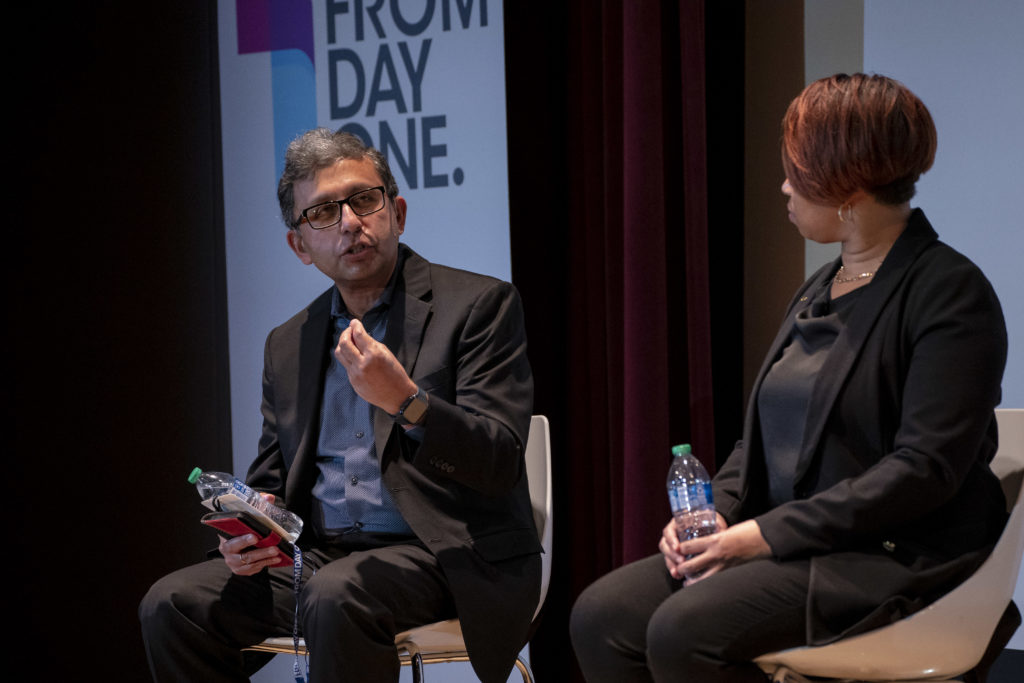Is Your Company Developing an Inclusive Culture?


Instead of looking for a “culture fit” in new employees, how can companies make their workplace better-suited to diversity? How much do career growth and employee retention add to a company's reputation for inclusion? These are some of the questions that journalist Steve Scher asked a panel of experts at From Day One’s January conference in Seattle, focused on “Listening to What Workers Want.” Here’s what the panel members had to say about how companies can develop a more inclusive culture:
Listen and Make Sure Everyone is Heard
“When people come to you with what concerns them, listen,” said Steve Zwerin, director of the HR Investigations Unit for the City of Seattle. “People feeling heard will go a long way. Empathy goes a long way, especially right now. Everybody’s suffering from the bottom of the organization all the way to the top.” Zwerin also emphasized the importance of being transparent. If something’s broken, don’t just talk about how you can fix it, but outline steps you’re taking and the actual fixes you’re making.
Empathy is key to effective listening, added Denise Bañuelos, director of equity, inclusion and diversity & workforce development for Kaiser Permanente Washington. Employees know there’s a process to file a complaint with the Employee Relations department, or through the compliance department, but they often want to connect with someone they have a relationship with to get some guidance, she said. “We listen, even though it’s out of our scope, and hear their whole story,” Bañuelos said. “We’re listening for clues of where there may be not necessarily a violation of policy, but an inclusive issue, or lack thereof, or respect, or the bordering line on potential discrimination–microaggression.”
Employees are often reticent to bring problems related to diversity, equity and inclusion (DEI) to company leaders, points out Madhukar Govindaraju, CEO of Numly, an AI-enhanced, peer-coaching platform. “People need forums, they need help, and support. If you can enable that with whatever mechanisms, then it becomes really effective. And so, for me, that’s what excites me day-to-day when I talk to my own team, as well as my customers and partners. What are they solving today? What is the problem? And how we can bring that to bear?”
“At the end of the day, people want to be heard," said Cassandra Mitchell, SVP of DEI strategy and engagement at KeyBank in Seattle. “People want to know that whether it’s their opinion, perspective, whatever it is, people are hearing and listening to them. And so whether we agree with it or not, we allow that space.”
Implement Unconscious Bias Programs
Both Kaiser Permanente and Keybank have enterprise-wide programs designed to increase employees’ understanding of how bias can impact decisions and begin to dismantle racism in the workplace.

“If you have a brain, you have a bias,” Bañuelos said. “Everyone’s born with it. It can be positive, it can be negative, and just breaking that down and understanding how your brain works and how it can be effective or ineffective in the way we do work [can be helpful].” At her company, employees view the hour-long program sessions independently, and then come together with other employees for a debrief. The goal is for them to voice where they see discrimination happening in their workgroup, and discuss how to stop it.
“We encourage small-group discussions, but it’s not required,” Mitchell said of KeyBank’s efforts. “But you know, the small-group discussion is really what has the impact, right? Because people can go through the training, kind of check the box, and set it aside in their mind.” KeyBank has created toolkits to make it as easy as possible for people to discuss these sometimes uncomfortable issues together.
The Benefits of Peer Coaching
About ten years ago, Numly’s Govindaraju did an experiment partnering with his HR leader around reverse mentoring, in which junior employees counsel more senior ones. He required managers to do reverse mentoring with their teams and it was such a big success that years later it led to Numly's peer-coaching program. “You can connect with anybody,” he said. “In fact, we force managers to be learners, with potentially coaches who are not managers within your organization.” The idea is that when a manager becomes vulnerable and says they want to learn from someone farther down on the corporate ladder, that’s a show of strength.
According to Govindaraju, there are two parts to creating an inclusive culture through peer coaching: one is e-learning and the other is human interaction. Both of these components have been incorporated into his company's platform. “When you enable people to work with each other,” he said, “you will find a change in culture.”
Jennifer Haupt is a Seattle-based author and journalist.
The From Day One Newsletter is a monthly roundup of articles, features, and editorials on innovative ways for companies to forge stronger relationships with their employees, customers, and communities.